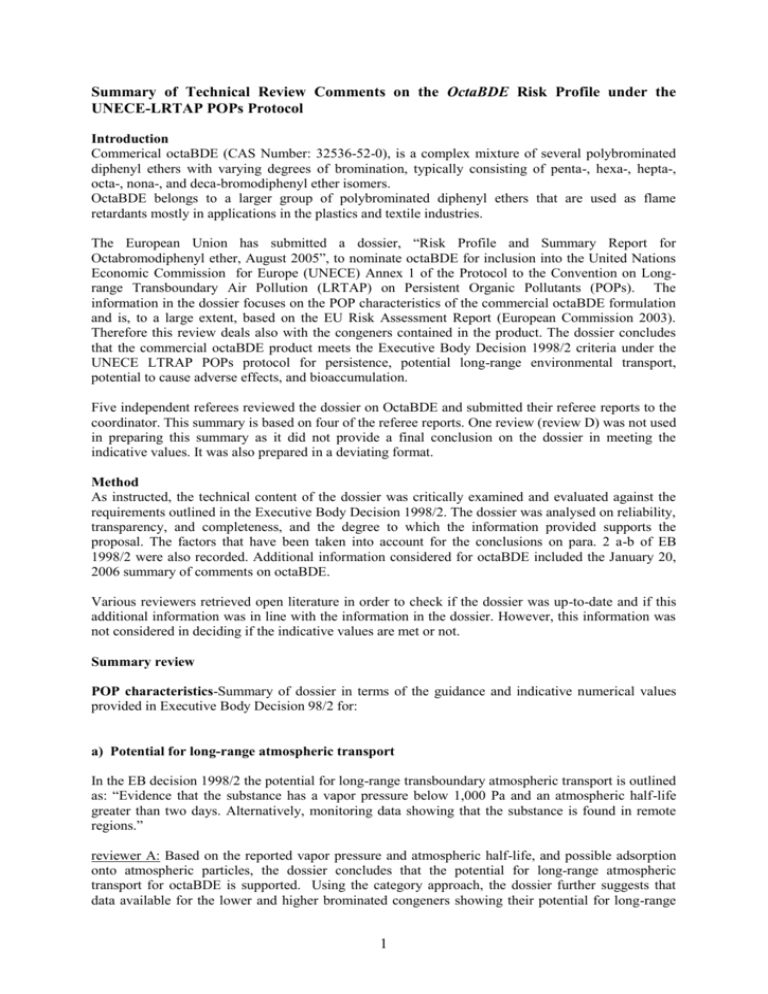Summary of Technical Review Comments on the OctaBDE Risk
advertisement

Summary of Technical Review Comments on the OctaBDE Risk Profile under the UNECE-LRTAP POPs Protocol Introduction Commerical octaBDE (CAS Number: 32536-52-0), is a complex mixture of several polybrominated diphenyl ethers with varying degrees of bromination, typically consisting of penta-, hexa-, hepta-, octa-, nona-, and deca-bromodiphenyl ether isomers. OctaBDE belongs to a larger group of polybrominated diphenyl ethers that are used as flame retardants mostly in applications in the plastics and textile industries. The European Union has submitted a dossier, “Risk Profile and Summary Report for Octabromodiphenyl ether, August 2005”, to nominate octaBDE for inclusion into the United Nations Economic Commission for Europe (UNECE) Annex 1 of the Protocol to the Convention on Longrange Transboundary Air Pollution (LRTAP) on Persistent Organic Pollutants (POPs). The information in the dossier focuses on the POP characteristics of the commercial octaBDE formulation and is, to a large extent, based on the EU Risk Assessment Report (European Commission 2003). Therefore this review deals also with the congeners contained in the product. The dossier concludes that the commercial octaBDE product meets the Executive Body Decision 1998/2 criteria under the UNECE LTRAP POPs protocol for persistence, potential long-range environmental transport, potential to cause adverse effects, and bioaccumulation. Five independent referees reviewed the dossier on OctaBDE and submitted their referee reports to the coordinator. This summary is based on four of the referee reports. One review (review D) was not used in preparing this summary as it did not provide a final conclusion on the dossier in meeting the indicative values. It was also prepared in a deviating format. Method As instructed, the technical content of the dossier was critically examined and evaluated against the requirements outlined in the Executive Body Decision 1998/2. The dossier was analysed on reliability, transparency, and completeness, and the degree to which the information provided supports the proposal. The factors that have been taken into account for the conclusions on para. 2 a-b of EB 1998/2 were also recorded. Additional information considered for octaBDE included the January 20, 2006 summary of comments on octaBDE. Various reviewers retrieved open literature in order to check if the dossier was up-to-date and if this additional information was in line with the information in the dossier. However, this information was not considered in deciding if the indicative values are met or not. Summary review POP characteristics-Summary of dossier in terms of the guidance and indicative numerical values provided in Executive Body Decision 98/2 for: a) Potential for long-range atmospheric transport In the EB decision 1998/2 the potential for long-range transboundary atmospheric transport is outlined as: “Evidence that the substance has a vapor pressure below 1,000 Pa and an atmospheric half-life greater than two days. Alternatively, monitoring data showing that the substance is found in remote regions.” reviewer A: Based on the reported vapor pressure and atmospheric half-life, and possible adsorption onto atmospheric particles, the dossier concludes that the potential for long-range atmospheric transport for octaBDE is supported. Using the category approach, the dossier further suggests that data available for the lower and higher brominated congeners showing their potential for long-range 1 atmospheric transport can also be used to support a concern that octaBDE would behave similarly. reviewer B: The proposal refers to the data evaluated during the EU risk assessment procedure on octaBDE. It shows that the indicative numerical values given in EB 1998/2 regarding vapour pressure and atmospheric half-life are exceeded. Monitoring data from remote regions show that also higher brominated congeners are susceptible to long range atmospheric transport. Reviewer C: The information provided in the dossier is sufficient. OctaBDE meets the indicative values mentioned in EB 1998/2 for potential for long-range transboundary atmospheric transport. The conclusion was based on vapour pressure and half-life in the atmosphere. Reviewer E: Commercial octaBDE technically satisfies the screening requirement for the potential for long-range transboundary atmospheric transport when attached to particles; Overall conclusion All reviewers concluded that the commercial OctaBDE meets the indicative value for long-range transboundary atmospheric transport. This conclusion is based on vapour pressure and half-life. Furthermore it is stated that monitoring data show the suspectibility to long range atmospheric transport of some components of OctaBDE. b) Toxicity and Ecotoxicity Toxicity is described in the EB 1998/2 decision as: “potential to adversely affect human health and/or the environment.” No further indicative values on toxicity are given in the EB 1998/2 decision. Reviewer A: The dossier further states that the EU Risk Assessment recommended that octaBDE be classified as “Toxic”, and that the commercial octaBDE product fulfills the Executive Body Decision 1998/2 criteria with regard to the potential for adverse effects on human health or the environment. reviewer B: Based on the hazard potential concerning human health and concern of toxic effects to predators octaBDE fulfils the requirement of EB Decision 1998/2 with regard to the potential for adverse effects on human health and /or the environment. Reviewer C: The information provided in the dossier is sufficient. OctaBDE meets the criteria mentioned in EB 1998/2 for toxicity and ecotoxicity, at least due to the lower brominated diphenyl ethers in the commercial mixture. Reviewer E: Commercial octaBDE has the potential to adversely affect human health and/or the environment. Overall conclusion All reviewers concluded that the commercial OctaBDE meets the indicative value for toxicity and ecotoxicity c) Persistence In the EB 1998/2 decision persistence is defined as: “evidence that the substance's half-life in water is greater than two months, or that its half-life in soils is greater than six months, or that its half-life in sediments is greater than six months.” Alternatively, evidence that the substance is otherwise sufficiently persistent to be of concern within the scope of the protocol may also fulfill this criterion. Reviewer A: The dossier reports that available laboratory test data indicate octaBDE is expected to have mineralization half-lives greater than 2 months in water and greater than 6 months in soils and sediment, and concludes that octaBDE is considered to be persistent in the environment. 2 reviewer B: The proposal concludes that octaBDE is persistent in the environment. However under certain environmental conditions (e.g. anaerobic state in soil) degradation might occur leading to the formation of lower brominated congeners, which are also of high concern. The proposal reported no experimentally determined half-lives. However, from the information submitted it can be concluded that the indicative numerical values given in EB 1998/2 are likely to be met and that the substance is sufficiently persistent to be of concern within the scope of the protocol. Reviewer C: The information provided in the dossier, is sufficient. OctaBDE meets the criteria mentioned in EB 1998/2 for persistency. The conclusion was based on the fact that the based on available laboratory test data, octaBDE is considered to be persistent in the environment and is expected to have mineralization half lives of >2 months in water and >6 months in soil and sediment. This was supported by literature data on congeners present in OctaBDE. Reviewer E: Commercial octaBDE meets the LRTAP POPs guidance for environmental persistence Overall conclusion All reviewers concluded that the commercial OctaBDE meets the indicative value for persistence. The reviewers cited the mineralization half lives of >2 months in water and >6 months in soil and sediment mentioned in the dossier. d) bioaccumulation In EB 1998/2 decision bio-accumulation: (i) Evidence that the BCF or BAF for the substance is greater than 5,000 or the log Kow is greater than 5; or (ii) Alternatively, if the bio-accumulative potential is significantly lower than (i) above, other factors, such as the high toxicity of the substance, that make it of concern within the scope of the protocol. Reviewer A: The dossier concludes that an assessment of the bioaccumulation potential of commercial octaBDE is complicated by the fact that it is a complex mixture of several polybrominated diphenyl ethers with varying degrees of bromination, and that the bioaccumulative properties vary with bromine content. The dossier cites a log octanol-water partition coefficient (Kow) of 6.29 for commercial octaBDE and suggests that experimental results indicate octaBDE does not bioconcentrate. The dossier concludes that no significant bioconcentration of octaBDE itself is expected, but the lower brominated congeners that are components of the commercial mixture (pentabromodiphenyl ether and hexabromodiphenyl ether) are considered to be highly bioaccumulative, with BCFs greater than 5,000. reviewer B: The assessment of the bio-accumulation potential of commercial octaBDE is not unambiguous. The log Kow representing the first screening criteria for bio-accumulation exceeds the indicative numerical value according EB 1998/2. BCF values in aquatic organisms span a range from 5 600 to < 9.5, the main components hepta- and octaBDE exhibit BCFs < 100. However evidence exists that higher brominated congeners metabolise to less brominated compounds which are also of high concern. Available monitoring data on PBDEs including heptaBDE show trophic transfer and indications for ecological magnification. Though not all indicators for bio-accumulation are met by all components of commercial octaBDE there is sufficient information available that bio-accumulation does occur from the release of commercial octaBDE in the environment. Reviewer C: The information provided in the dossier is sufficient. OctaBDE meets the criteria mentioned in EB 1998/2 for bioaccumulation. The log Kow reported in the dossier is 6.29. The dossier concludes that based on its octanol-water partition coefficients octaBDE would be expected to be bioaccumulative, but that experimental results 3 indicate that octaBDE does not bioconcentrate, probably due to its large size precluding crossing of cell walls in organisms. Additional literature is provided. Sellström et al (2005) provides an excellent figure (Figure 2) on the relationship between logKow and bioaccumulation from soil/sediment to animal factor (BSAF). It shows that also in the higher brominated diphenyl ethers a high bioaccumulation factor can be expected. Reviewer E: OctaBDE does not meet the LRTAP POPs guidance for bioaccumulation based on the evidence presented. Information beyond that conveyed in the risk profile is available for consideration of the <12% hexaBDE component Overall conclusion Three reviewers concluded that the commercial OctaBDE meets the indicative value for bioaccumulation. These reviewers mentioned that the log Kow representing the first screening criterion for bio-accumulation exceeds the indicative numerical value according EB 1998/2. They also indicated that the assessment of the bio-accumulation potential of commercial octaBDE was not unambiguous as the commercial OctaBDE is a mixture of BDE’s with different characteristics and as experimental results show that octaBDE does not concentrate. Reviewer number 4 concluded that OctaBDE does not meet the POPs guidance for bioaccumulation based on evidence presented. However, this reviewer stated that information beyond that conveyed in the risk profile is available for consideration of the <12% hexaBDE component Monitoring or equivalent scientific information suggesting long-range transboundary atmospheric transport – Summary of the dossier in terms of EB Decision 1998/2-2a Reviewer A: According to the dossier, available monitoring data show that octaBDE is found mainly in soils and sediments close to sources of release; monitoring data for remote areas are not available for octaBDE itself. To fill this data gap, the dossier uses the category approach and considers the available data for the lower and higher brominated congeners to support a concern for the long-range transboundary atmospheric transport. Additional support comes from the vapor pressure and atmospheric half-life, which appear to meet the Executive Decision 1998/2 screening criteria. Reviewer B: Though monitoring data on octaBDE isomers are scare sufficient information exists that some congeners contained in octaBDE formulations undergo LRAT and are liabel to bio-accumulate in apical arctic predators. The profile of commercial octaBDE concerning monitoring data is less detailed but serves the purpose to show that these compounds are detected in abiotic and biotic samples in regions far from their source. Reviewer C: The dossier concludes that there are no monitoring data from remote locations available for octaBDE itself. The available monitoring data generally show that octaBDE is found mainly in sediments and mainly close to sources of release. Limited monitoring data in air from remote areas of Sweden found no octaBDEs to be present, but found indications of the presence of hexabromodiphenyl ethers and heptabromodiphenyl ethers associated with the particulate phase. The dossier also concludes that the lower brominated congeners (e.g. pentabromodiphenyl ethers and hexabromodiphenyl ethers) present in the commercial octaBDE appear to be subject to long-range environmental transport, possibly by the atmosphere, as they are widely found in sediment and biota in remote areas. Reviewer E: Commercial octaBDE does not exhibit the semivolatile properties and propensity for LRAT that are the hallmarks of most problematic POPs. HexaBDE has been detected more regularly and at higher concentrations in remote locations and may be more likely subject to LRAT. Overall conclusion Three reviewers indicate that there are no or limited data from remote areas, but that the dossier 4 points out that sufficient information exists that some congeners contained in octaBDE formulations undergo LRAT. The fourth reviewer indicate that commercial octaBDE does not exhibit the semivolatile properties and propensity for LRAT, but that hexaBDE has been detected more regularly and at higher concentrations in remote locations and may be more likely subject to LRAT. HexaBDE is one of the congeners present in commercial OctaBDE (<12%) Sufficiency of the information to suggest that the substance is likely to have significant adverse human and/or environmental effects resulting from its long-range transboundary atmospheric transport – Summary of the dossier in terms of EB Decision 1998/2-2b Reviewer A: Sufficient or suitable information was not presented in the dossier and therefore the proposal does not meet the criteria to support the statement whether commercial octaBDE is likely to have significant adverse human and/or environmental effects resulting from its long-range transboundary atmospheric transport. Reviewer B: Though congeners contained in commercial octaBDE do not belong to the most abundant PBDEs detected in the environment their hazard profile combined with their ubiquitous occurrence in the environment including top predators far from their sources implicates that adverse effects on human health and the environment cannot be excluded. Reviewer C: The dossier concludes that available data indicate that penta- and hexabromo diphenyl ethers have a much higher bioconcentration potential than the other components of octaBDE and so are likely to have a higher potential to cause adverse effects on organisms in the environment. Therefore the presence of lower brominated diphenyl ethers in the commercial octaBDE products is of concern. Reviewer E: No information is provided in the dossier to support a determination that commercial octaBDE is likely to have significant adverse effects resulting from its long-range atmospheric transport. Overall conclusion: Two reviewers (B & C) conclude that by using a category approach, the available data for the bioconcentration potential of the lower brominated congeners present in the commercial octaBDE mixture, support a concern for environmental effects. One reviewer (A) concludes that the dossier provide no information to support that commercial octaBDE is likely to have significant adverse effects resulting from its long-range atmospheric transport and one reviewer(E) concludes that the dossier does not specifically address nor provide evidence to support the specific statement linking effects to long-range transport, that is, "that commercial octaBDE is likely to have significant adverse human and/or environmental effects resulting from its long-range transboundary atmospheric transport". Conclusions on the technical content of the dossier Reviewer A: "For the most part, while the dossier provided a reasonable and logical case in favor of supporting the proposal that commercial octaBDE meets the individual screening criteria outlined in the Executive Decision 1998/2 for persistence, potential long-range environmental transport, potential to cause adverse effects, and bioaccumulation, sufficient or suitable information was not presented in the dossier and therefore the proposal does not meet the criteria to support the statement whether commercial octaBDE is likely to have significant adverse human and/or environmental effects resulting from its long-range transboundary atmospheric transport. Moreover, in order to fill data gaps where data on commercial octaBDE were limited or altogether absent, the dossier uses the category approach to support a concern. This approach is entirely reasonable; however, there are some instances where the relevancy of using data from other lower or higher brominated congeners is not completely 5 clear, or lacking in sufficient detail to support using them, leaving the reader with many unanswered questions. In most of these instances, a stronger case could be made by simply adding more complete detailed information. The reviewer mentions examples where insufficient information is presented or where transparency is lacking, e.g., toxicological data." Reviewer B: The technical content of the dossier is robust and sufficient to fulfil the requirements of EB 1998/2. Most information contained in the proposal originates from the EU Risk Assessment Report, which can be regarded as trustable and a high rated data source. However some sections could be more elaborated e.g. toxicological data. Also the consideration of recent research and work could have strengthened the proposal. It was not always clear if information/test results refer to the octaBDE isomers or to the commercial formulation. Reviewer C: The dossier is written in a compact and easy readable style. The literature used in the dossier is up-to-date. The dossier provides enough information for screening against the indicative values of the POP characteristics. Reviewer E: The risk profile, although dated August 2005, is several years out of date regarding the scientific literature, relying primarily on an EU Risk Assessment Report (2003) where data collection had terminated in 2002. Overall, the risk profile was concisely written and consistent with the 2003 European Union Risk Assessment Report on octaBDE on which it was based. A central finding of the EU Report highlighted that there is a need for further information and/or toxicity testing. This is noteworthy because the date of last literature search and technical review for the EU Report was in 2002 (EU Report 2003) and, although the LRTAP risk profile was prepared in August 2005, it contains virtually none of the extensive contemporary literature on the PBDEs published during this interval. This is a serious deficiency. The deficiency is more noteworthy as this concern for contemporary information was raised during the previous reviews of LRTAP risk profiles, but does not appear to have been addressed. A single supplementary citation submitted by the Canadian government for consideration (Gerecke et al., 2005), while informative regarding debromination potential, does not compensate for the volume and quality of research undertaken in over the last three to four years. Several of the LRTAP EB Decision 1998/2 requirements were not addressed, notably EB Decision 98/2 2(a) and 2(b), precluding the ability to conclude that they have been satisfied. Overall conclusion The reviewers stated that for the most part, the dossier provided a reasonable and logical case in favor of supporting the proposal. The risk profile was concisely written and consistent with the 2003 European Union Risk Assessment Report. However, it was also mentioned that in many instances, the dossier is lacking in transparency, completeness, and in sufficient detail to support the proposal and that the dossier does not contain the most recent literature. Reviewer no. 4 even states ‘Ít contains virtually none of the extensive contemporary literature on the PBDEs published during this interval (2002-2005). Two reviewers indicate that the dossier does not specifically address nor provide evidence in support of EB decisions 98/2 2(a) and 2(b) and indicate this is a serious deficiency. Guidance of the EB on the precise interpretation of decisions EB 1998/2 2a and 2b concerning the dossier requirements and the reviewers task would be welcome. 6






